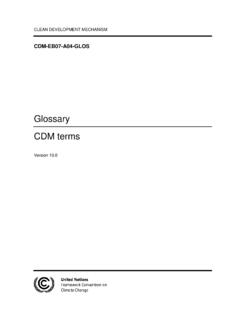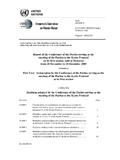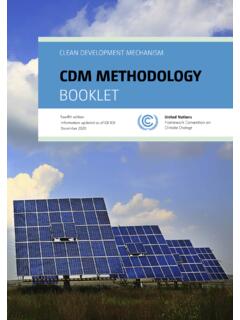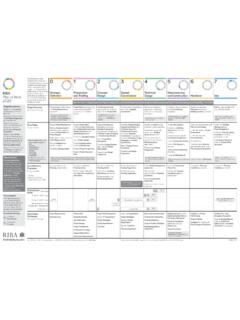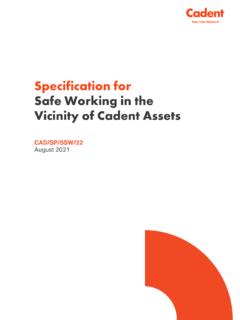Transcription of BOOKLET - CDM: CDM-Home
1 United NationsFramework Convention onClimate ChangeChaptername Xxxzz, Sample Text Secont Line Lorem Ipsum DoloreCDM Methodology BOOKLET November 2017 (up to EB 97)CDM METHODOLOGYBOOKLETCLEAN DEVELOPMENT MECHANISMN inth editionInformation updated as of EB 97 November 2017 United NationsFramework Convention onClimate ChangeUnited NationsFramework Convention onClimate ChangeCDM Methodology BOOKLET November 2017 (up to EB 97)Acknowledgement 2 Foreword 3 Introduction Methodologies and the BOOKLET Categorization by mitigaion activity type (methodology categorization table) Categorization by applied technology type/measure (methodology family trees)
2 Programmes of activities Standardized baselines Methodologies addressing suppressed demand Methodologies having benefits for women and children Introduction to methodology Summary sheets 26 Icons, abbreviations and glossary Icons used in this BOOKLET Abbreviations used in this BOOKLET glossary 36 Methodologies for CDM Project activities Introduction to Methodologies for CDM project activities Methodological tools for CDM project activities Methodologies for large-scale CDM project activities Methodologies for small-scale CDM project activities 164 Methodologies for afforestation and reforestation (A/R) CDM project Activities Introduction to methodologies for A/R CDM project activities Methodological tools for A/R CDM project activities Methodologies for large-scale A/R CDM project activities Methodologies for small-scale A/R CDM project activities 268 TABLE OF CONTENTSU nited NationsFramework Convention onClimate ChangeCDM Methodology BOOKLET November 2017 (up to EB 97)ACKNOWLEDGEMENT 2017 United Nations Framework Convention on Climate ChangeFirst edition: November 2010 Second edition: November 2011 Third edition: May 2012 Fourth edition: November 2012 Fifth edition: November 2013 Sixth edition: November 2014 Seventh edition: November 2015 Eighth: November 2016 Ninth and current edition: November 2017 Available online.
3 < >The production of this BOOKLET benefited from the suggestions of Secretariat staff and thoughtful comments from several experts on the content that wouldbe most helpful to people wishing to find and understand methodologies and methodological tools of interest to them. In order to enhance its utility and respond to the needs of stakeholders the Secretariat welcomes comments and suggestions, which can be emailed to: BOOKLET will also be updated regularly in order to reflect changes in approved methodologies and methodological tools. The latest version of the BOOKLET is available on the UNFCCC website. It is also possible to contact the Secretariat and request USB sticks of the further information contact:United Nations Climate Change SecretariatUN CampusPlatz der Vereinten Nationen 153113 Bonn, GermanyTelephone +49. 228. 815 10 00 Telefax +49. 228. 815 19 Cover Christos Anagnostopoulos CDM project 0740: Zafarana Wind Power Plant ProjectPage 4 Pedro Guinle CDM project 1843: Primavera Small Hydroelectric ProjectPage 29 Nic Bothma CDM project 0079: Kuyasa low-cost urban housing energy upgrade project, Khayelitsha (Cape Town.)
4 South Africa)Page 40 Mi Wenju CDM project 1320: Beijing Taiyanggong CCGT Trigeneration ProjectPage 47 Adeel Halim CDM project 0826: Bagasse based Co-generation Power Project at KhatauliPage 164 Burkhard Seifert CDM project 2969: CDM LUSAKA SUSTAINABLE ENERGY PROJECT 1 Page 261 Yi Zhang-Energy Systems International CDM project 0894: Xinjiang Dabancheng Sanchang First Phase Wind Farm ProjectPage 265 Dwarakaa CDM project 2941: Biomass based power project at T-Kallupatti village, Madurai District, Tamil Nadu, IndiaPage 268 Ruben Loy CDM Project 0297, LaGeo, de , Berlin Geothermal Project, Phase Two Art direction and design: Phoenix Design Aid A/SISBN 978-92-9219-174-03 United NationsFramework Convention onClimate ChangeCDM Methodology BOOKLET November 2017 (up to EB 97)The international community achieved a resounding success with the new, universal climate change agreement adopted at COP21 in Paris in December 2015.
5 The Paris Agreement marks a historic turning point in our common journey towards a secure and sustainable world. The Paris Agreement will shape international climate policy for the next decades. It holds great challenges, but also exciting, transformational opportunities driven by ambitious national action and increased international Paris Agreement is a catalyst for policies and action for low-carbon development, climate finance, technology transfer, capacity building and market-driven approaches. For market-based approaches, different types of contributions and units are available for transfer. Compatibility, comparability and fungibility among these units ensures there is no double counting and safeguards environmental integrity. Internationally recognized standards to quantify emission reductions is key for environmental integrity is crucial for the Clean Development Mechanism, or CDM, and methodologies form the foundation for integrity.
6 Methodologies help establish a project s emissions baseline, or anticipated emissions if the project does not move forward. They also help monitor, quantify and accurately estimate emissions once a project is built. Eligible certified emission reduction units are determined by the difference between the baseline and actual emissions. Methodologies are essential to quantify real and accurate emission reductions. Standardized baselines allow methodologies also to cover sector-wide the necessity of methodologies is easy to understand, how they are constructed is quite complex. To make standards applicable to projects from diverse sectors, techno-economic situations and geographical regions, they must be diverse in composition and application. This publication is designed to guide users through the complex world of CDM BOOKLET clearly summarizes mitigation methodologies available under the CDM.
7 This can help market actors choose the right method to estimate their emission reductions. It is my firm belief and that of the team that developed this work, that this will contribute to more CDM projects where there is larger impact on sustainable development. This holds great potential to improve the livelihoods of people, reduce poverty, promote better health, directly benefit women and children and enhance the regional distribution of projects, which is a key desire of Parties to the Kyoto Protocol, the CDM Executive Board and this has played a critical role in promoting climate action on the ground in more than one hundred developing countries and remains one of the most successful running international market mechanisms. It is clear from the Paris Agreement that the CDM will continue to be an important tool in meeting the climate change challenge, and this report helps accomplish that Grabert, DirectorSustainable Development Mechanisms (SDM)United Nations Framework Convention on Climate ChangeUnited NationsFramework Convention onClimate ChangeChaptername Xxxzz, Sample Text Secont Line Lorem Ipsum DoloreCDM Methodology BOOKLET November 2017 (up to EB 97)INTRODUCTIONC hapter ICDM Methodology Booklet5 United NationsFramework Convention onClimate ChangeCDM Methodology BOOKLET November 2017 (up to EB 97) METHODOLOGIES AND THE BOOKLETBASELINE AND MONITORING METHODOLOGIESThe Clean Development Mechanism (CDM) requires the application of a baseline and monitoring methodology in order to determine the amount of Certified Emission Reductions (CERs)
8 Generated by a mitigation CDM project activity in a host country. Methodologies are classified into five categories: Methodologies for large-scale CDM project activities; Methodologies for small-scale CDM project activities; Methodologies for large-scale afforestation and reforestation (A/R) CDM project activities; Methodologies for small-scale A/R CDM project activities; Methodologies for carbon capture and storage (CCS) project often refer to methodological tools, which address specific aspects of the project activity, to calculate Greenhouse Gas (GHG) emissions from specific OF THE BOOKLETThis BOOKLET provides concise summaries of CDM methodologies and description of methodological tools, approved by the CDM Executive Board (Board). It is arranged to assist CDM project developers in identifying methodologies that are suitable for their CDM project The general purpose of the BOOKLET is to help in achieving the objective of the Board to raise awareness of CDM OF THE BOOKLETThe BOOKLET is intended for use by varied audiences interested in the CDM and in particular potential CDM project developers who already have an idea of the mitigation project activities they intend to implement.
9 It facilitates the initial selection of potentially applicable methodologies. However, it cannot provide detailed guidance on specific elements of each methodology nor replace the approved methodologies. Therefore, the project developers should refer to the original methodologies available on UNFCCC CDM methodologies edition of the BOOKLET reflects the effective status of methodologies and methodological tools as of November 2017 (up to EB 97). However, as methodologies and methodological tools may change, users of the BOOKLET are encouraged to consult EB meeting reports subsequent to EB 97 to find out whether any changes have OF THE BOOKLETEach methodology is presented through a one-page summary sheet, which provides the following information: Typical project(s) to which the methodology is applicable; Type(s) of GHG emission mitigation action; Important conditions for application of the methodology; Key parameters that need to be determined or monitored; Visual description of baseline and project short textual description of each methodological tool is also contained in the TO FIND A SUITABLE METHODOLOGY1.
10 CATEGORIZATION BY MITIGATION ACTIVITY TYPE This way of looking up methodologies is according to the relevant sectoral scopes and type of mitigation activities such as renewable energy, low carbon electricity generation, energy efficiency measures, fuel and feedstock switch, GHG destruction, GHG emission avoidance, displacement of a more-GHG-intensive output and GHG removal by sinks. Project developers knowing the type of mitigation activity to be implemented in their project activities can thus easily identify potentially suitable methodologies. 2. CATEGORIZATION BY APPLIED TECHNOLOGY TYPE/MEASURE This second way of looking up methodologies focuses on the technology applied in the project activity. The categorization by technology type enables project developers to identify a set of comparable methodologies applicable to the technology that is going to be implemented in their project activities.
